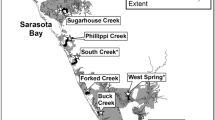Abstract
The NOAA Center of Excellence for Oceans and Human Health Initiative (OHHI) at the Hollings Marine Laboratory (HML) is developing a data management framework that supports an integrated research program across scientific disciplines. The primary focus of the database is to support environmental research focused on tidal creek watershed systems. Specifically, the current data holdings include physical water quality parameters, nutrients, pathogens, chemical contaminants, benthic and nekton species abundances and human dimensions data from Georgia, North Carolina and South Carolina dating to 1994. These data are not from a single long-term research project but are derived from several state and federal research programs and integrated into a common database model to support current research being conducted under the OHHI program at HML. The Tidal Creek database was developed with the intent to support a well documented and open system, thus metadata elements from common metadata standards including the Dublin Core ISO 15836:2003 and Federal Geographic Data Committee (FGDC-STD-001-1998) are components of the database model. The result is a semantic database framework with descriptive ancillary data at the record level including methods, investigator names, date, locations and other descriptive elements. The primary users of the database are project personnel to meet analytical needs. The database is also available through a number of web-based applications that are designed to give users the necessary information to evaluate and access data. In addition, data can be accessed with Open Geospatial Consortium (OGC) standards, and species records and abundances are being made available to the Ocean Biogeographic Information System (OBIS). Overall, the Tidal Creek database summarizes the response of tidal creeks and watersheds to coastal development, and serves as a repository for environmental, demographic, and socioeconomic data in the Southeast.
Similar content being viewed by others
References
Ausubel, J. H. (1999). Toward a census of marine life. Oceanography, 12(3), 4–5.
Halpin, P. N., Read, A. J., Best, B. D., Hyrenbach, K. D., Fujioka, E., Coyne, M. S., et al. (2006). OBIS-SEAMAP: Developing a biogeographic research data commons for the ecological studies of marine mammals, seabirds, and sea turtles. Marine Ecology Progress Series, 316, 239–246.
Holland, A. F., Sanger, D. M., Gawle, C. P., Lerberg, S. B., Santiago, M. S., Riekerk, G. H. M., et al. (2004). Linkages between tidal creek ecosystems and the landscape and demographic attributes of their watersheds. Journal of Experimental Marine Biology and Ecology, 298, 151–178.
Environmental Protection Agency (1993). A review of ecological assessment case studies from a risk assessment perspective. (EPA/630/R-92/005). Washington, DC: US Environmental Protection Agency.
Environmental Protection Agency (1994). Peer review workshop on ecological risk assessment issue papers. (EPA/630/R-94/008). Washington, DC: US Environmental Protection Agency.
Lerberg, S. B., Holland, A. F., & Sanger, D. M. (2000). Responses of tidal creek macrobenthic communities to the effects of watershed development. Estuaries, 23, 838–853.
National Centers for Coastal Ocean Science (2007). National Centers for Coastal Ocean Science human dimensions strategic plan (FY2009-FY2014). National Oceanic and Atmospheric Administration, National Ocean Service, National Centers for Coastal Ocean Science, Silver Spring, MD.
National Research Council (1999). From monsoons to microbes: Understanding the ocean's role in human health. Washington, DC: National Academy Press.
National Research Council (2001). Climate, ecosystems, and infectious disease. committee on climate, ecosystems, infectious disease, and human health. board on atmospheric sciences and climate division on earth and life studies. Washington, DC: National Academy Press.
National Research Council (2002). Problems, promise and products. Washington, DC: National Academy Press.
Sanger, D. M., Holland, A. F., & Scott, G. I. (1999a). Tidal creek and salt marsh sediments in South Carolina coastal estuaries. I. Distribution of trace metals. Archives of Environmental Contamination and Toxicology, 37, 445–457.
Sanger, D. M., Holland, A. F., & Scott, G. I. (1999b). Tidal creek and salt marsh sediments in South Carolina coastal estuaries. II. Distribution of organic contaminants. Archives of Environmental Contamination and Toxicology, 37, 458–471.
Van Dolah, R. F., Sanger, D. M., & Filipowicz, A. B. (Eds.) (2004). A baseline assessment of environmental and biological conditions in the May River, Beaufort County, South Carolina. South Carolina Department of Natural Resources Final Report.
Van Dolah, R. F., Riekerk, G. H. M., Bergquist, D., Felber, J., Chestnut, D. E., & Holland, A. F. (2008). Estuarine habitat quality reflects urbanization at large spatial scales in South Carolina’s coastal zone. Science of the Total Environment, 390, 142–154.
Author information
Authors and Affiliations
Corresponding author
Rights and permissions
About this article
Cite this article
White, D.L., Wolf, D., Porter, D.E. et al. Development of a data management framework in support of southeastern tidal creek research. Environ Monit Assess 150, 323–331 (2009). https://doi.org/10.1007/s10661-008-0233-6
Received:
Accepted:
Published:
Issue Date:
DOI: https://doi.org/10.1007/s10661-008-0233-6




